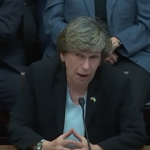The College Board’s SAT Money Hustle
A recent report alleged that the College Board, the architects of the college entrance exams known today as the SAT, is becoming a profit-driven (yet taxpayer-funded) machine, instead of a business focused on the greater good. The National Center for Policy Analysis’s latest report, “The Big Business Profitability of the Nonprofit College Board,” highlights how profits are driving the nonprofit College Board.
The report gave a background on the two tests, which may not be well-known by the general populace. For example, the SAT was originally used after World War One to screen for scholarships while testing applicants’ innate intelligence. It was first administered to over 8,000 students in 1926, and since then, it has grown to 1.7 million for the actual SAT in 2015 and 2.5 million students have taken the College Board’s Advanced Placement (AP) courses. By comparison, in 2011, under 2 million students took AP courses.
According to the National Center of Education Statistics, 49% of graduates take the SAT, which means that it could be a profitable business venture for the College Board. A high school guidance counselor named Bob Sweeney said, “College Board is capitalizing on the perceived and exaggerated importance of the SATs.” He claimed, “The fees are symptomatic of the frenzy of it all, how much we’ve all put the testing and the results on a pedestal.”
To Sweeney’s point, the report noted how test prep tutors can charge from $100 to $200 an hour, in addition to students rushing their scores to their colleges. The Cooperative Institutional Research Program’s Freshman Survey of 2015 noted that 28.5% of incoming freshman applied to seven or more colleges. The report outlined how the official SAT study guide is $24.99, with the SAT test costing $45. Add an essay to the test costs $13 more, and to rush the tests to colleges, it costs $31 for the first college and $11.25 for each additional college. If that isn’t enough, the College Board charges $15 for scores by telephone.
The AP tests are another lucrative fee model for the College Board. The test costs at least $89 to take, with late tests costing $45 and late payments $225. The school district is charged $45 for “printing and delivering exams for students with special needs.” However, the AP courses have not been proven to effectively prepare high school students for college courses. For example, 40% of students in Illinois in 2016 scored poorly on the tests (below a 3 on a 5-point scale). So far, taxpayers have poured over $400 million since 2005 on a federal level, which brings into question why taxpayers continue to pay for AP courses and tests.
What are the salaries of the College Board executives? Ex-president Gaston Caperton, who served until October 2012, earned $1,147,739 in bonuses in addition to his $445,095 base salary, and $203,048 in other compensation. David Coleman, the current CEO and who was behind Common Core’s design, earned a total of $732,192 in 2013. Their AP and instruction program earned $383 million in 2014, and their SAT and PSAT assessment programs earned $333 million.
Some challenges, the report conveyed, are competition from the ACT (a test that relies on subjects such as reading, math and science) and at least 850 colleges not using the ACT or SAT for their admissions process. Adding to these challenges is Coleman’s push to align the SAT to Common Core, thus changing the nature of the test for intelligence to a test of knowledge of Common Core course material. Two other tests are being used on a smaller scale, the Classic Learning Initiatives (CLT) and a developing exam called the Vector Assessment of Readiness for College (ARC) pose challenges for the SAT and the College Board.




